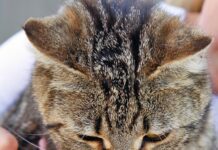Whiskers are one of the things that make cats such agile, successful hunters. These thin hairs provide details about the environment.
Whiskers Are Long Hairs
Your cat’s whiskers are big, specialized hairs. What makes them so special is the hair follicle that they grow from. Whisker follicles are deeper than your cat’s regular hair follicles and are lined with lots of nerve endings. When a whisker is touched or moved by the wind, different nerves are stimulated based on how the whisker bends. The stimulated nerves then send information to your cat’s brain. Most cats have straight or slightly curved whiskers, but cats with curly coats can have curly whiskers, too.
Pinpoint Prey
Whiskers are moved by even the tiniest air currents. Your cat interprets the way air is moving to tell if a person or animal is moving toward her or away and how fast. Cats use this talent to help detect prey and track its movements. You’ll notice that when your cat is actively stalking something—be it a real mouse or a toy one—her whiskers are flared and a little forward. She is totally focused on tracking every motion of her prize. Once your cat has caught her prey, the whiskers on her face, jaw, and paws all help her to sense exactly how it is oriented in her grasp. This makes up for the fact that she can’t see well up close. From this information, she can deliver the killing bite or just chomp on her toy.
Trimming Doesn’t Hurt (but it’s rude)
Because whiskers themselves are just hairs, they can be cut. The shaft of the whisker does not have any nerve endings, and it won’t hurt. Plucking a whisker is another story. Whiskers are deeply rooted in the skin, which makes them harder to remove, and don’t forget all those nerve endings. Plucking a whisker from your cat’s face will hurt.
Even though trimming whiskers doesn’t hurt, it’s not a great thing to do. You probably know that one of the ways cats use their whiskers is to “measure” how big an opening is to tell if they will fit. If the whiskers are cut short, they no longer accurately represent your cat’s body size.
Cutting your cat’s whiskers can interfere with the rest of your cat’s life as well. Her whiskers help her to navigate in the dark, as her movements create air currents that then bounce off walls and furniture and back to her.
Shedding Is Normal
Like all hairs, whiskers can shed and fall out on their own. Your cat won’t lose all her whiskers at once, and they will grow back. Your cat’s whiskers may change color as she ages, just like human hair turning gray. Except many cats’ whiskers get darker as they age.
Whiskers on a Cat’s Legs
Cats’ facial whiskers are the most obvious, but they also have whiskers on the back of the front legs. These whiskers are shorter than facial whiskers, but still longer and thicker than normal fur. Your cat uses these whiskers to feel prey that she has caught and to aid in jumping and climbing. This helps her to land lightly and gracefully, even on narrow targets.ν




